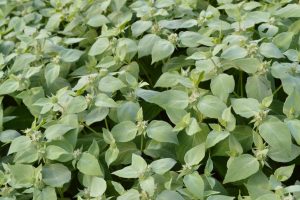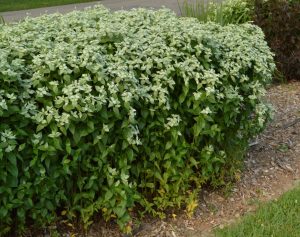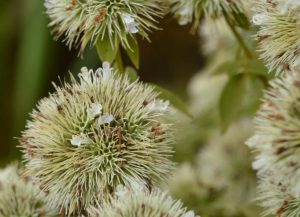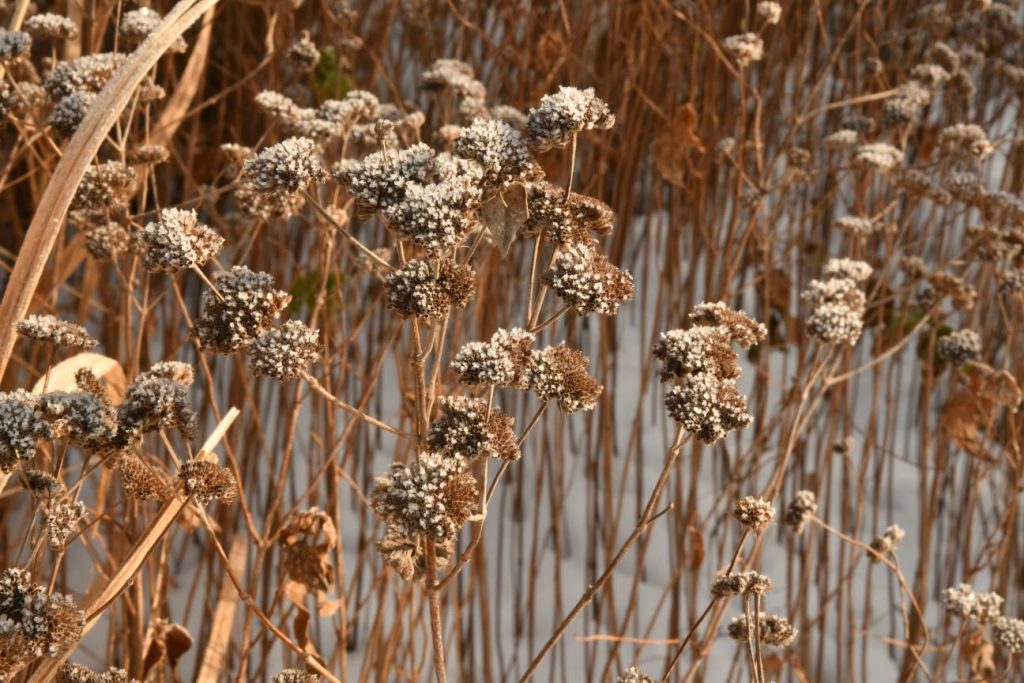Mountain Mint – Truly, a Gardeners Mint
Mint is a plant that conjures up a multitude of thoughts and emotions among gardeners. Typically, our first thought is of a plant with wonderfully fragrant foliage that happens to combine well with Ice Tea and Mint Juleps! Unfortunately, this is matched with an equally unsettling vision of a plant that knows no boundaries and will rapidly spread throughout your garden! True mints are found within the genus Mentha, and their aggressively spreading nature makes them problematic in an ornamental garden. However, there are other plants in the mint family or Lamiaceae that display a far greater degree of garden refinement and manners. Mountain Mint, botanically known as Pycnanthemum muticum, is one such member of the Lamiaceae and it defies my imagination as to why this plant is not more popular among gardeners.
Mountain Mint is certainly not a new plant to the world of horticulture. It was first discovered by the French botanist Andre Michaux (1746-1802) in 1790, when he found masses of the plant growing in Pennsylvania! Michaux initially named and described the plant as Brachystemum muticum, which was published posthumously in 1803 in his work Flora Boreali-Americana. Interestingly, in the same book he described a new genus named Pycnanthemum! Both names are from the Greek to describe the flower structure; Brachys means short and Stelma means column while Pyknos means dense and Anthos means flower. It only took a few years for the French botanist and mycologist Christiaan Hendrik Persoon (1761-1836) to assign the proper genus name in 1806. The species epithet comes from the Latin Muticus for blunt, perhaps a reference to the dome-shaped or blunt appearance of the apical flowers. Although the common name is Mountain Mint, it actually does not grow in alpine regions, but rather in open, moist fields and forest edges, which can be located along the lower elevations of a mountain.
 Personally, I was not introduced to this plant until 2010 while touring Central Park. It appeared periodically throughout the park as a 2-3’ tall mass of shimmering silver along the edge of woodlands and ponds. Although the day was cloudy and it was mostly growing beneath a canopy of tall trees, the plant gave the impression of sunlight cutting through openings in the branches and illuminating the forest floor beneath. The gentleman leading the tour mentioned how these masses of Mountain Mint had been installed in an effort to reduce weeds. Naturally, I thought it was another invasive mint and was about to dismiss the plant when he noted it was merely a dense, ‘weed-suppressing’ plant and not invasive. A weed suppressing, non-invasive mint – my interest in this plant began to grow!
Personally, I was not introduced to this plant until 2010 while touring Central Park. It appeared periodically throughout the park as a 2-3’ tall mass of shimmering silver along the edge of woodlands and ponds. Although the day was cloudy and it was mostly growing beneath a canopy of tall trees, the plant gave the impression of sunlight cutting through openings in the branches and illuminating the forest floor beneath. The gentleman leading the tour mentioned how these masses of Mountain Mint had been installed in an effort to reduce weeds. Naturally, I thought it was another invasive mint and was about to dismiss the plant when he noted it was merely a dense, ‘weed-suppressing’ plant and not invasive. A weed suppressing, non-invasive mint – my interest in this plant began to grow!
The shimmering, silvery effect of the plant was not the result of a true flower petal, but rather a pair of silver colored bracts or modified leaves that subtend the terminal boss of small white to light pink flowers, as seen in the image above. Much like Poinsettias and our native Flowering Dogwood, the actual flowers are very small and the primary impact is created by these bracts. For Pycnanthemum, they provide a beautiful ornamental effect for over 3 months! The flowers themselves are roughly ⅛” long, white with pink markings and are densely arranged in a ½” diameter compressed flower structure called a cyme. It is this dense arrangement of flowers that sparked the crafting of the two initial genus names. The flowers open over a 3 month period beginning in June and are a great source of nectar for bees, beneficial wasps, moths and butterflies! In fact, it is rare that the plants are not a flurry of activity when in bloom. Come winter, the clusters of dried seed capsules atop the stems have a nice winter presence, especially with a heavy December frost as pictured at the end. My interest in this plant grew even further!
 The lance-shaped, dark green foliage, measures 2-2 ½ inches long and is much like a typical mint, the foliage is very aromatic when rubbed. Tightly clad to the square stems by only a short petiole, the foliage contains pulegone, an oil with an aroma reminiscent of spearmint that is very effective at repelling mosquitoes when rubbed on the skin. This aroma is also effective at eliminating deer browse!
The lance-shaped, dark green foliage, measures 2-2 ½ inches long and is much like a typical mint, the foliage is very aromatic when rubbed. Tightly clad to the square stems by only a short petiole, the foliage contains pulegone, an oil with an aroma reminiscent of spearmint that is very effective at repelling mosquitoes when rubbed on the skin. This aroma is also effective at eliminating deer browse!
Mountain Mint is a great plant for working into the Garden. It looks great paired with the silver foliage of Lamb’s Ear (Stachys lanata) and it is great at brightening the darker foliage of deep purple leaved plants like Purple Leaved Smoketree (such as Cotinus coggygria ‘Velvet Cloak’). I have found that the plants and stems have a very vertical appearance that can make a design look awkward when planted along the edge of a planting (as pictured at left) since the transition to the ground plane is very abrupt. It is best to have a lower growing plant or a mounding plant placed at the front of Mountain Mint to provide a more gentle transition to turf, a walkway or simply the ground plain. Plants grow well in full sun as well as light shade, providing that the soil does not become excessively dry for prolonged periods. The plants are adaptable to various soil types and pH; they are typically found growing on alkaline soils in the wild, but are tolerant of acidic soils and are surprisingly tolerant of moister soils along pond edges. The soils simply cannot remain waterlogged with ponding water for extended periods of time. The rhizomes do spread about 4-6” per year, but they are easily cut with a garden spade and the shallow stems are easily extracted, even if they have started to grow into a neighboring plant. This is a practice that should typically be done every other year.
 If more of a clump forming species is of interest consider Pycnanthemum flexuosum or Appalachian Mint. Originally named Origanum flexuosum in 1788 by the American botanist Thomas Walter (1740-1789), its name was altered a century later in 1888 by Nathaniel Lord Britton (1859-1934). Britton was the American botanist who went on to cofound the New York Botanical Garden! The species epithet means pliant and is probably a reference to the flexible stems. Growing 2-3’ tall and roughly as wide, the dense root system is great for soil stabilization and since the foliage is also aromatic, it too is resistant to deer browse. The flower clusters or cymes lack the silvery bracts of its cousin, but they are much larger, typically around 1 ½” in diameter (as pictured at right). The purple flecked, white flowers remain rather diminutive, with the ¼” long tubular flowers appearing for nearly 2 months throughout the summer. Like its cousin, they are also exceptionally attractive to pollinators. Unlike its cousin, each flower has a more pronounced calyx or leafy base that initially serves to protect the flower bud and then physically support the tubular flower. Once the flower fades and drops away, each of the 5 off-white sepals that compose the calyx have a long bristly spur at the tip, giving the flower head a Sputnik or fuzzy appearance. The ultimate effect produces a bit more drama to the flower and the Garden, which I found very ornamental! This species has similar cultural requirements as its cousin and both are hardy throughout NJ, easily enduring a zone 5 winter and the summer’s heat.
If more of a clump forming species is of interest consider Pycnanthemum flexuosum or Appalachian Mint. Originally named Origanum flexuosum in 1788 by the American botanist Thomas Walter (1740-1789), its name was altered a century later in 1888 by Nathaniel Lord Britton (1859-1934). Britton was the American botanist who went on to cofound the New York Botanical Garden! The species epithet means pliant and is probably a reference to the flexible stems. Growing 2-3’ tall and roughly as wide, the dense root system is great for soil stabilization and since the foliage is also aromatic, it too is resistant to deer browse. The flower clusters or cymes lack the silvery bracts of its cousin, but they are much larger, typically around 1 ½” in diameter (as pictured at right). The purple flecked, white flowers remain rather diminutive, with the ¼” long tubular flowers appearing for nearly 2 months throughout the summer. Like its cousin, they are also exceptionally attractive to pollinators. Unlike its cousin, each flower has a more pronounced calyx or leafy base that initially serves to protect the flower bud and then physically support the tubular flower. Once the flower fades and drops away, each of the 5 off-white sepals that compose the calyx have a long bristly spur at the tip, giving the flower head a Sputnik or fuzzy appearance. The ultimate effect produces a bit more drama to the flower and the Garden, which I found very ornamental! This species has similar cultural requirements as its cousin and both are hardy throughout NJ, easily enduring a zone 5 winter and the summer’s heat.
Interestingly, both species began their affiliation with horticulture under different and distantly related genera within the mint family, only to find out they were in fact closely related cousins. My interest and admiration for what these plants can provide for the Garden only continues to grow as I continue to find new ways to incorporate these plants in designs! Granted, no plant is perfect, since neither of these Mints should be eaten or used as a garnish in a glass of Ice Tea or a Mint Julep! However, if you have been searching for a deer resistant native plant that is friendly to pollinators, suppresses weeds and works well others, here are 2 mints that you surely want to add to your list of great garden worthy plants!

Bruce Crawford
State Program Leader in Home and Public Horticulture, NJAES



